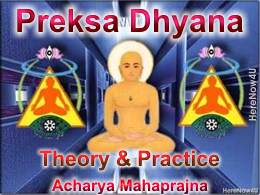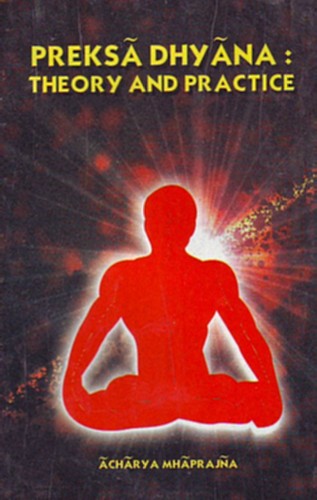
Practice of contemplation is an important exercise in the system of Preksa Dhyana. As stated earlier the practice of contemplation falls into two categories:
- To contemplate and reflect on what is eternal, true and real as the thought process concentrates on a single facet of reality, contemplation becomes a real experience and the practitioner is face to face with reality.
- To effect attitudinal changes by the process of auto suggestion and repeated recitation. This exercise is a practical application of will-power which has been developed and reinforced by prior practice and perceptual meditation. In this exercise, counter-vibrations capable of countermanding the effects or activators of negative attitude are generated.
In both categories of exercise, the practitioner eliminates muscular tension, maintains the motionless posture of the body, breathes slowly and rhythmically, and inhibits all agitation and excitation.
As stated earlier, contemplation is concentration of thought-process. Perception and awareness were primarily used for other meditational techniques such as 'Perception of Breathing'. Thinking was considered a distraction and was banished as far as possible. In this exercise the conscious mind is encouraged to engage itself in a thinking process. When thoughts are canalized and unidirectional, the exercise becomes meditation.
In the first category of exercise, the practitioner contemplates on an eternal or transcendental truth.
For instance, in the exercise of "Contemplation of Transitoriness", he contemplates that "Everything is associated with everything else by a transient relationship and hence the association must come to an end". On the basis of this basic principle, the practitioner starts the exercise by contemplating and reflecting on the obvious separateness of two associated gross objects, e.g. separateness of clothes and body. As the exercise proceeds, he contemplates or. the separateness of subtle and still more subtle (which is not quite obvious) e.g. separateness of urges and emotions from the conscious substance and further reflects on their dissociation. As the contemplation concentrates, the practitioner will realize the truth on the level of real experience.
In the second category of exercise, the practitioner resorts to the technique of auto-suggestion to cure physical sickness, mental imbalance and psychological distortions. He not only attains physical health and mental equilibrium but also develops a strong reasoning mind and rationalises his judgments by conscious reasoning. In other words, he acquires not only physical goodness but also psychical goodness by eradicating all evils from his thought, speech and action. He acquires the capability to transmute habitual negative attitude and psychological distortions and develops positive attitudes and internal harmony. For instance, by contemplation of fearlessness, the practitioner eradicates irrational fear. In this category of exercise, concentration of mental equipment is coupled with auto-suggestion.
The practitioner must first select and determine his objective, that is, he must identify and pin-point the specific evil distortion to be eradicated to acquire the corresponding virtue. His aim is attained by becoming what he wills to become and his tool is the technique of auto-suggestion. It must be remembered that until the selected objective does not reach the internal subconscious level, his willing will not be successful. One must learn to subdue one's conscious mind and activate the subconscious one. The desired image is to be projected upon the subconscious from the conscious level.
Next the objective is to be repeated in the form of a short sentence or syllable. Repeated repetition, first with a loud voice and then mentally, is to be continued for 5 to 10 minutes daily in every exercise. The continuity should not be broken. Response is likely to vary from person to person. Some may achieve full success in a short time while others may take a longer time to do so; but success is always there. Thus, the process of auto-suggestion is very important in the development of physical, mental and spiritual good. Acharya Mahaprajna
Acharya Mahaprajna

